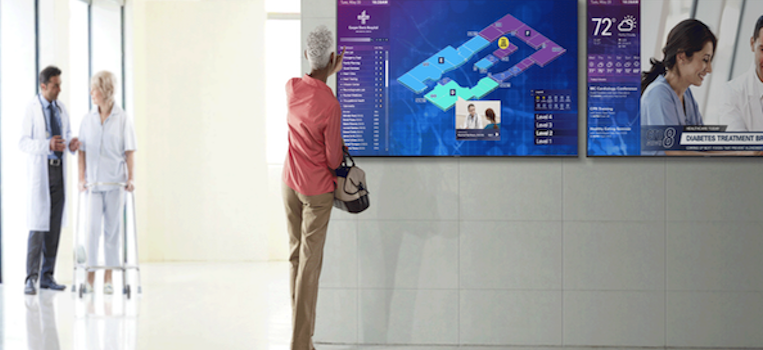Digital signage has been trending across industries for years, and it’s only growing. The global digital signage market is projected to reach $27.8 billion by 2026. That equates to an impressive compound annual growth rate of 11.2 percent.
Fueling that growth, in part, is the healthcare sector, which is turning to digital signage in hospitals and doctor’s offices to enhance the patient experience. These days, it’s hard to find a hospital or doctor’s office that doesn’t use digital signage in some capacity, whether it’s a wall-filling display for donor recognition or several interactive displays used to improve wayfinding, inform staff, educate patients or communicate important information to visitors. After all, effective communication is key to delivering positive health outcomes.
The trick to maximizing return on investment (ROI) from digital signage in hospitals is prioritization. Hospitals have a lot of information to communicate, but which messages matter most? That depends on your organization, your team and your patients.
Implementing digital signage in hospitals: Questions to ask
Planning and mapping your healthcare digital signage is a big job, one that works best when the conversation includes technical leaders, business leaders, staff leaders and patient experience leaders — in other words, everyone who has a stake in internal or external communications.
Reimagine healthcare facility design — brilliantly
Discover how digital displays can empower caregivers, engage patients, and elevate health brands. Download Now
When transforming hospitals with digital signage, healthcare leaders have a lot to think about. For example, where should displays be installed? What information should be shared on them? What type of display will work best to deliver that information? But before addressing the specifics, take a step back and consider the bigger picture, answering the following questions about your larger business or organizational needs:
1. What are your greatest communication challenges?
Strong communication is important in every aspect of running a hospital, but where are the biggest gaps in your organization? This could include:
-
Wayfinding: If you run a large hospital or medical complex, chances are you have a wayfinding problem, where staff members are consistently interrupted throughout the day by people asking for directions. Interactive displays, including Samsung’s QBR-T Series, allow healthcare organizations to share crystal-clear maps and directions with passersby, making the most of their wall space.
- Waiting room: The Samsung Kiosk allows patients to check in without waiting in line or talking with a hospital employee. After check-in, digital displays in the lobby, such as the QBR Series and Pro TV, can show queuing information for patients, relieving the stress of wondering when their name may be called for their appointment. With the split screen setting on the QBR Series, hospitals can leave queuing information on one half while displaying educational messages about general health topics or urgent safety information on the other.
-
Patient engagement: Bedside digital whiteboards can be used to keep patients fully up to date about their care, helping reduce anxiety. Smart signage can also deliver educational content tailored to each patient’s condition. With Samsung’s range of healthcare TVs — specifically designed to improve the patient experience — patients can enjoy best-in-industry brightness and color uniformity, making their stay more comfortable while delivering clear visuals for improved education.
-
Informing staff: Digital signage in break rooms, nurses stations and other common areas can display staff schedules, reminders about upcoming training or hospital events, safety warnings, introductions to new team members and staff recognition. Displayed on 4K UHD screens, like those in Samsung’s QMR Series and QBR Series, the most up-to-date information is always available to hospital staff, so they can stay informed without having to sort through papers or rely on legacy PC equipment.
-
Communicating with visitors: Hallway displays can be used to promote hospital services, deliver wellness content, solicit donations, alert visitors to public safety concerns, estimate wait time for clinic patients and keep families informed in surgical waiting rooms. Samsung’s The Wall can boost a hospital’s image from the moment visitors walk in. For example, you can set up The Wall to share heartfelt testimonials and stories from the hospital’s donors. A donor wall can showcase exactly what makes your organization special and cultivate a more comforting atmosphere, starting in the lobby.
2. What are your top business priorities?
Most hospitals today face the same challenges: improve health outcomes and patient satisfaction, decrease readmission rates and cut costs. But where are you currently struggling most? In other words, where could implementing digital signage produce the greatest ROI and make the greatest impact on your strategic business goals?
3. Which messages need to be delivered in real-time?
When deciding what content should be displayed, prioritize information that changes frequently — the kind of messages that would quickly become outdated on a bulletin board.
Digital signage is also a great way to grab attention and highlight ongoing content, but if space is limited, consider whether there are other ways to communicate certain information. This ensures that staff and visitors are getting the most up-to-date, pertinent messages wherever they are in the hospital.
With a content management solution like MagicINFO — an all-in-one platform that connects everything in your digital ecosystem — hospital staff can easily create and deploy updated content as often as they need to. For example, when the COVID-19 pandemic first hit, safety protocols and guidelines were evolving day by day. With a robust content management system (CMS) like MagicINFO, healthcare organizations can communicate their best practices on an ongoing basis, keeping everyone better informed.
Samsung’s LYNK Cloud can be used to analyze patients’ content use within their room, which enables healthcare organizations to deliver optimized promotions or educational content while providing a better, more personalized patient experience.
4. Which patients/staff would be best served by digital signage?
Patients, staff and visitors all benefit from improved communication, but who would benefit most in your organization? Are there certain departments where digital signage could make the biggest difference? Are there common patient and visitor complaints that digital displays could help to address instead of requiring constant staff attention?
5. Which problems are best solved by digital signage?
Once you’ve identified and prioritized your key communication challenges, consider what kind of digital signage is the best solution for each one. For example, do you want to showcase inspirational content to visitors? A Samsung QLED display would suit that need perfectly. Need a way to easily communicate patient status, allergies and whereabouts? You might want to place small interactive displays outside patient rooms.
In addition to these five considerations, digital signage plans should be physically mapped out. For IT decision makers, this may mean collaborating with hospital staff to identify high-traffic areas, such as main hallways or patient rooms, that would most benefit from increased information visibility. This will help you narrow down what you need, whether it’s a brand-new hospital donor wall or a fleet of LED displays for your waiting rooms.
After answering these big-picture questions, you’ll be better prepared to develop an effective implementation plan for your digital signage. Ultimately, by identifying your organization’s greatest communication gaps, you’ll be well on your way to bridging them.
As you continue to plan your digital signage rollout, get more tips on using an integrated CMS to configure and tailor real-time messaging in this free, complete guide. And discover more healthcare technology solutions built to increase your care teams’ efficiency and improve the patient experience.









